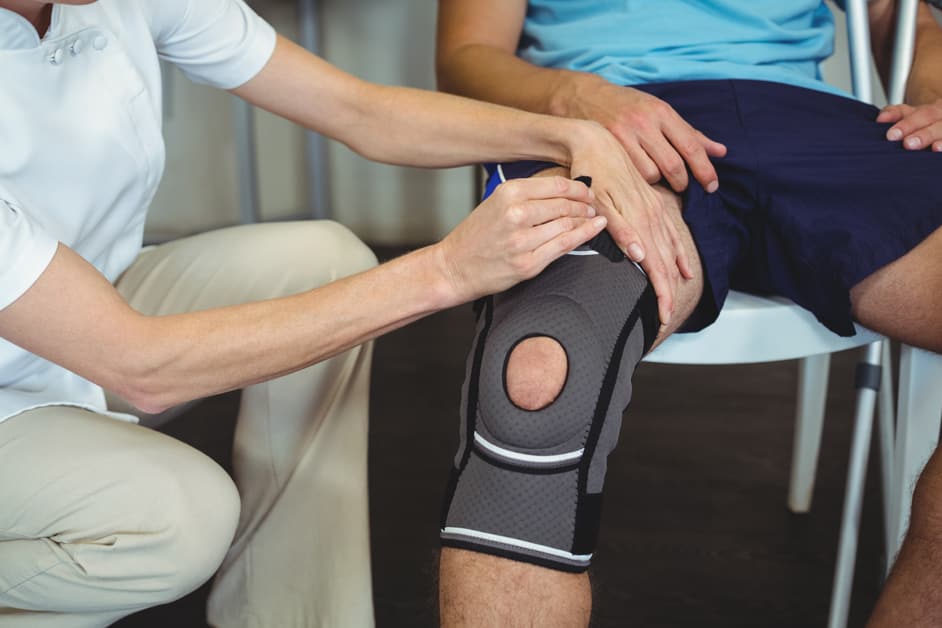Introduction
Knee pain can be both painful and debilitating. It is common from lower body injuries, osteoarthritis, and overuse. Many people with knee pain find it affects their daily activities. There is no guaranteed cure, but prevention can help avoid chronic issues.
Braces and supports are an option to help prevent knee pain. They provide support and stability to an injured joint or weak muscle. This helps recovery and decreases pain from these conditions.
This article will look at:
- Types of braces and what they do
- How braces work
- When to use braces
- Cautionary measures when wearing one
Types of Knee Support
Knee pain prevention? Support is key! Braces, sleeves, orthotics and stretching – many knee support options! Each has advantages and disadvantages – research to find the best for you. Let’s discover the most popular types of knee support:
Knee Braces
Knee braces are a popular way to prevent and treat knee injuries and pain. They come in many styles, each with a purpose. For general knee pain, neoprene sleeves with adjustable straps are good. They provide compression, reduce swelling, and help the recovery process.
Hinged knee braces offer more support. They give ligament stability and allow you to move fully. They are often used for ACL tears and other serious knee injuries such as meniscus tears or dislocations. Some hinged braces also have side bars for extra support and protection from a fracture.
If you have osteoarthritis or chronic knee pain, an unloader brace can help. It takes the weight off of the damaged area and puts it on healthier parts of your leg when you move. This reduces the pain. A posture brace is good for osteoarthritis. It keeps your knees in alignment while walking and reduces pressure on the cartilage.
Knee Sleeves
Knee sleeves provide light knee support. They allow freedom of movement, and keep wearers warm too. These are usually made from heavyweight Lycra or nylon, and sometimes offer compression too. Knee sleeves cover the entire joint, from the upper leg to the kneecap. You can slip them on quickly, which is why athletes like them.
When picking a sleeve, make sure it’s well-padded around the sides and back of your knee. It should also fit snugly around your calf. Athletes who play sports like volleyball or basketball can benefit from this flexibility. If you have chronic knee pain after surgery or an injury, talk to a medical professional first.
Knee Wraps
Knee wraps are popular in weight-training. They fit snugly around the knee and lower leg. Made of elastic material like neoprene, they offer warmth, compression and extra stability, with adjustable Velcro fasteners. They should be slightly loose, not tight so as to restrict movement or circulation.
People use them preventatively, not to treat knee pain or injury. Other forms of kneecap support are better for existing knee issues.
Knee wraps give control during dynamic motions involving the knee joint, like squats and lunges with heavy equipment. When used right, they can improve performance better than taping techniques, with compression without reducing flexibility.
For all your lifting goals, you need a great pair of knee wraps. You get warmth, comfort and reliable support!
Benefits of Knee Support
Knee support can be useful for those with knee pain. Braces, wraps and supports can reduce pain, give more stability and stop other issues. Let’s look at the advantages of knee support:
- Reduces pain
- Provides stability
- Prevents further issues
Pain Relief
Knee support is often used to treat various knee joint injuries, such as tears in the meniscus, ACL injuries, patellar tendinitis, and runner’s knee. It helps protect knees from further stress or harm during sports or exercise. As the injury heals, knee supports help stabilize the joint and reduce pain.
For those with arthritis, knee supports can help with chronic pain in joints. They also reduce inflammation and protect the area from worse damage. Knee supports increase blood circulation and reduce stiffness. They can cushion against hard surfaces and prevent too much movement of the joint.
Knee support is beneficial for:
- Decreasing inflammation
- Offering relief from pain caused by chronic illness or injury
This way, users can get back to their daily activities quickly and safely, without risking further harm or discomfort.
Prevention of Injury
Knee support products offer the necessary support to reduce injuries and knee pain. To choose the best product, figure out the type of knee injury. Popular choices include knee sleeves, kneepads, hinged and stabilizing braces.
Knee sleeves provide compression for stability and protection against tendonitis, meniscus tears and arthritis during physical activity. Kneepads are hard material covering each kneecap and great for activities which involve kneeling on hard surfaces.
Hinged braces are adjustable straps giving strength and reducing instability during movement. Stabilizing braces use strain-management systems to protect joints and distribute force throughout the genu-femoral area. Perfect for heavy lifting and sports activities.
Improved Mobility
Choosing the right knee support can help you avoid pain and injury. It can also improve your mobility. Supports that use compression or stabilization around the knee joint can limit movement and make it more secure. This boosts agility and speeds up recovery. It’s great for casual and professional athletes.
- Compression sleeves or braces with supportive fabrics that fit around the joint are good for activities such as running, cycling, or weightlifting. Breathable fabrics can reduce swelling.
- If you’ve suffered an injury, a stronger brace with metal plates may be recommended. This sturdier option helps control range of motion in sports like basketball and soccer.
How to Choose the Right Knee Support
Knee support is key to avoiding and easing knee pain. How to pick the right one? Here’s a guide! It’ll help you make a smart choice that fits your needs. Consider these factors when selecting a knee support:
- Type of injury
- Level of support needed
- Fit and comfort
- Durability
- Breathability
Consider Your Activity Level
When picking a knee support, think about your activity level. Knee supports come in a range of styles for different needs. Lightweight ones have flexible fabric and adjustable straps and buckles. Firmer ones are sturdier.
If you’ll do activities with sudden movements like sports or hiking, choose one with extra knee stability and support options. Stabilizer straps, wraparound designs, extended straps can offer stability and reduce swelling. For high-level activities like running marathons, choose knee braces with cushioning around the knee joint area.
By thinking about your activity and the type of activities with your brace, you can decide the right support for your knees!
Consider the Type of Support
Knee supports can help with injury prevention and management. Different types provide different levels of protection and comfort. Consider:
- Compression knee sleeves – light compression and comfy fit. Great for general stability during exercise and mild support during daily activities.
- Kinesiology tapes – light compression, reduces pain from certain injuries, and helps muscles heal faster.
- Hinged braces – stabilize joint and offer moderate support. Great for weak ligaments or arthritis flare-ups.
- Functional/Rehab braces – restrict unwanted movement, limit stress on injured area. Can feature adjustable straps, Velcro closures.
Talk to a healthcare provider to ensure the right support for your needs.
Consider the Level of Support Needed
When selecting a knee support, it’s important to consider the amount of support you need. It can range from a simple neoprene sleeve to keep the knee warm and give minimal support, or an adjustable semi-rigid brace that can offer more movement restriction and extra stability for activities such as running or hiking.
Braces come in multiple sizes to ensure an optimal fit and air flow. An appropriately fitting brace is essential, as an ill-fitted one may not deliver the desired level of support. Some braces have hinges which can limit motion in one direction, yet allow full range of motion in another direction. Additionally, straps and levers can help adjust the compression around the knee joint.
It’s also important to look for quality construction when selecting a knee support. Look for breathable materials that will keep you cool and wick away sweat, but also provide enough stiffness and support for your needs. Make sure there are no rough edges or bulky seams that could be uncomfortable during use. Lastly, check care instructions; many knee supports can be machine washed and dried, while others may require gentle handwashing or spot cleaning.
Conclusion
Finally, selecting the right knee brace can lessen your pain and safeguard your joint from more harm. It’s optimal to collaborate closely with your physician and physical therapist, if available, to determine the ideal knee support for you.
Dedicating time to evaluate your needs and make an informed decision about a treatment plan which includes supportive items like braces, support wraps, is the key to proper knee care and can provide you relief from your anguish.
Frequently Asked Questions
Q: What types of braces are available for knee pain prevention?
A: There are many types of braces available for knee pain prevention, including hinged braces, patellar braces, knee sleeves, and neoprene wraps. Each type of brace offers different support for the knee and should be chosen based on individual needs and circumstances.
Q: Are there any exercises that can help prevent knee pain?
A: Yes, there are many exercises that can help strengthen and support the knee to prevent pain. Some of these exercises include squats, lunges, leg extensions, and leg curls. It is important to speak with a doctor or physical therapist before beginning any exercise program.
Q: Are there any lifestyle changes that can help prevent knee pain?
A: Yes, there are several lifestyle changes that can help with knee pain prevention. Maintaining a healthy weight and being active can help reduce stress on the knee joint. Wearing the right footwear and using proper technique during physical activities can also help reduce the risk of knee pain.





